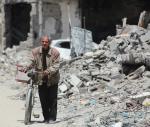You are here
Not to forget education of Syrian refugees in Jordan
Feb 02,2016 - Last updated at Feb 02,2016
The London conference will convene tomorrow to look into the best possible ways to support countries that are hosting Syrian refugees so they can continue providing humanitarian assistance as well as basic services, such as education, healthcare and social protection.
Jordan is shouldering the heaviest responsibility among all other host countries; it is hosting nearly 1.4 million Syrian refugees, which badly affects its education and healthcare systems.
Jordan is providing education services to about 145,000 Syrian children and youth; 20,000 of them are in refugee camps while the rest are attending host community government schools.
Additionally, UNICEF estimates that some 45,000 children are attending informal education courses, while 30,000 more children are out of school.
These numbers are expected to increase due to the continued influx of refugees, on the one hand, and the fact that 55 per cent of Syrian refugees are below the age of 18, on the other.
As a consequence, the Jordanian education system was negatively affected in many different ways. Due to this, the government resorted to extraordinary measures to meet the challenges of the influx of students.
The measures include:
— Converting 98 schools to double-shift schools that accommodate 13.4 per cent of all students.
— Shortening school time in order to accommodate double shifts, which resulted in reduced time-on-task, hence decreased learning opportunity.
— Increasing class occupancy rates in many schools, which resulted in overcrowding, increased social tensions and psychosocial problems.
— Appointing less qualified teachers to meet the demands of increased number of students.
— Continued dependence on rented schools that are not suitable as schools, to begin with.
Although these measures helped accommodate Syrian refugee students, their direct and indirect impact on the quality and sustainability of education services is phenomenal.
A decade-long effort to improve education in the country, as measured against UNESCO’s Education for All goals and the Millennium Development Goals, is now under the threat of being wasted.
Reducing the life span of education infrastructure due to pressure of overuse is another factor that is underestimated in all cost estimation of the Syrian crisis.
To meet these challenges, the Ministry of Education is embarking on a bold measure to accommodate all legible Syrian refugee students in the formal education system by opening additional schools on the basis of improved double shift, but this is a costly operation.
The ministry estimates that an additional $70 million are needed to do that.
This is a small investment compared to the estimated cost of the loss of human capital formation, due to the crisis situation.
As an example, UNICEF estimates in a recent report that this loss for Syria alone is $10.7 billion or about 17.7 per cent of the Syrian GDP in 2010.
It is also estimated that the socio-economic cost of not educating children is seven times higher than educating them.
The region and maybe the whole world will pay a heavy price for not educating Syrian refugees’ children and youth.
Is the world ready for that price?
Jordan has never shied away from its humanitarian responsibilities, but its limits are stretched thin. The country needs all the support that can come its way so it can shoulder its responsibility.
The writer is director general of ChangeAgent for Arab Development and Education Reform. He contributed this article to The Jordan Times.











